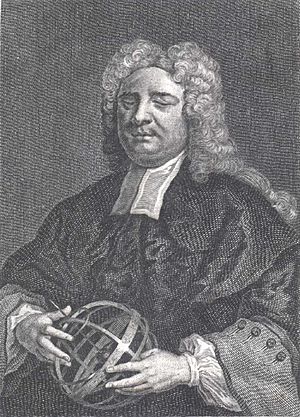Nicholas Saunderson facts for kids
Quick facts for kids
Nicholas Saunderson
|
|
|---|---|
 |
|
| Born | 20 January 1682 Thurlstone, Yorkshire, England
|
| Died | 19 April 1739 (aged 57) Cambridge, England
|
| Nationality | British |
| Alma mater | Penistone Grammar School University of Cambridge |
| Spouse(s) | Abigail Dickons |
| Children | 2 |
| Awards | Fellow of the Royal Society (1718) |
| Scientific career | |
| Fields | Mathematics |
| Institutions | University of Cambridge |
Nicholas Saunderson FRS (born January 20, 1682 – died April 19, 1739) was a brilliant English scientist and mathematician. He became blind when he was very young, but this didn't stop him from becoming a famous professor at Cambridge University. He held the same important job, called the Lucasian Professor of Mathematics, as other famous scientists like Isaac Newton and Stephen Hawking. Some people even think he might have been the first person to discover a very important idea in math called Bayes' theorem.
Contents
About Nicholas Saunderson
Nicholas Saunderson was born in a place called Thurlstone, Yorkshire, England, in January 1682. His parents were John and Ann Sanderson. When he was about one year old, he lost his sight because of smallpox. Even though he couldn't see, he learned arithmetic by helping his father, who worked as an excise man (someone who collected taxes).
As a child, it's believed he learned to read by touching the words carved on tombstones around St John the Baptist Church in Penistone. He went to Penistone Grammar School where he learned French, Latin, and Greek. Later, a tutor taught him algebra and geometry. In 1702, he studied logic and metaphysics at Attercliffe Academy near Sheffield.
Life at Cambridge
In 1707, Nicholas arrived in Cambridge. He stayed at Christ's College and could use their library. He really wanted to teach. The Lucasian Professor of Mathematics at the time, William Whiston, gave him permission to lecture. Nicholas taught mathematics, astronomy, and optics, and his students loved his lessons.
In 1710, Professor Whiston was removed from his position. Queen Anne then gave Saunderson a special Master of Arts degree in 1711. This made him eligible to take over Whiston's job. The very next day, he was chosen as the fourth Lucasian Professor. In 1718, he also became a member of the important Royal Society.
Nicholas lived at Christ's College until 1723. That year, he married Abigail Dickons, and they had two children, John and Anne. In 1728, King George II himself made him a doctor of laws. Nicholas Saunderson passed away on April 19, 1739, from scurvy. He was buried in the church at Boxworth, near Cambridge.
His Amazing Abilities
Saunderson was friends with many leading mathematicians of his time, including Isaac Newton and Edmond Halley. He had incredibly sharp senses of hearing and touch. He was also a very good flautist (someone who plays the flute).
He could do long and complex math problems entirely in his head! He also invented a special calculating machine, like an abacus, that he could use by touch. He called it his "palpable arithmetic." He wrote about this machine in his book, Elements of Algebra, which was published after he died. This book was even used at the Royal Military Academy, Woolwich.
His Work in Mathematics
Nicholas Saunderson was very important because he was a skilled and inspiring teacher. He taught at a time when mathematics was becoming very important at Cambridge University. As the Lucasian Professor, he helped explain Isaac Newton's ideas to students and other teachers.
Through his teaching, he helped change the old ways of learning at Cambridge. He made sure that mathematics and Newton's natural philosophy (ideas about how the world works) were central to the studies. He also provided the first clear introduction to Differential calculus, which is a key part of advanced math.
Saunderson didn't publish much of his work himself. However, his lecture notes were shared and used by many important people. These included astronomers like James Bradley and Samuel Vince, and even John Harrison, who taught himself math using Saunderson's notes before inventing the marine chronometer (a very accurate clock for ships). After he died, his book The Elements of Algebra in Ten Books was published.
Bayes' Theorem
The discovery of Bayes' theorem is a bit of a mystery in math history. We know it was discovered before Thomas Bayes wrote about it. Some historians believe Saunderson might have been the first to discover it. In those days, mathematicians often shared new ideas through private letters and talks, not always by publishing them.
One historian, Stephen Stigler, thinks Saunderson is the most likely discoverer after looking at old letters and discussions. However, other mathematicians have different ideas. It's a bit like a probability problem itself – we might never know for sure who discovered it first!
Legacy
Nicholas Saunderson even appears as a character in a novel from the 1700s called Letter on the Blind for the Use of those who can see by Denis Diderot. In the book, Saunderson's character represents someone with amazing logical skills but no sight. This shows how famous he was in his lifetime. He was seen as a symbol of genius, much like Stephen Hawking later became.
In Penistone, where he grew up, there's a memorial to Saunderson in St John's Gardens. His birthplace in Thurlstone used to have a special stone, which is now built into a wall in a small garden nearby. One of the old buildings and a house at Penistone Grammar School, along with a street called Saunderson Gardens, are named after him.
In 2006, Saunderson's life was even turned into a musical called No Horizon. It was performed at the Edinburgh Festival Fringe in 2016.
See also
 In Spanish: Nicholas Saunderson para niños
In Spanish: Nicholas Saunderson para niños
- Euclidean algorithm
- History of group theory

